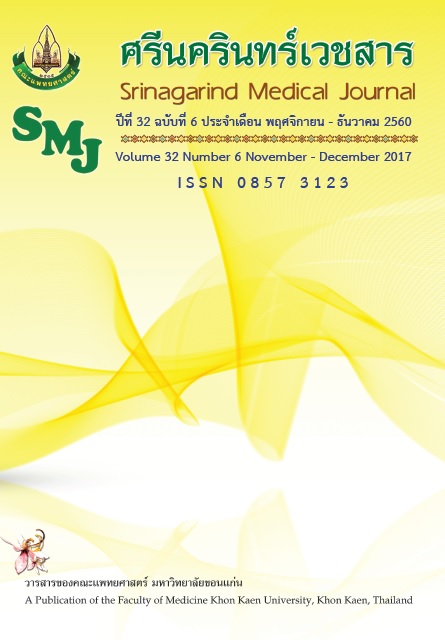Factors Related to the Access of the Emergency Room of Srinagarind Hospital Compared to Primary Care Unit of Khon Kaen University in Non-Urgency Undergraduate Students of Khon Kaen University
Keywords:
Factor of medical assessment; accidental and emergency department; primary care unit; Khon Kaen university; Srinagarind hospital; undergraduate student; ปัจจัยการเข้ารับบริการสุขภาพ; ผู้ป่วยไม่เร่งด่วน; ห้องฉุกเฉิน; หน่วยบริการปฐมภูมิ; มหาวิทยาลัยขอนแก่น; นักศึกษาปริญญาตรีAbstract
Background and Objectives: From statistics, 60% of the patients who went to accident and emergency department (AE) were non-urgent condition and 37% were undergraduate students, which should go to PCU first, causing AE overcrowding. The objective of this study was to examine factors related to the access of the AE of Srinagarind hospital in non-urgency undergraduate students of Khon Kaen university compared to the PCU.
Methods: The study was cross-sectional analytical study, which conducted with undergraduate students of KKU who visited AE of Srinagarind hospital or PCU with non-urgent condition during 4.00-8.00 pm. on weekday 24-27 March 2017. The sample size was calculated as 148 respondents which 37 at AE and 111 at PCU chosen by time frame allocation sampling to answer self-administered questionnaire. Analysed by binary and multiple logistic regression and resulted in COR, AOR and 95%CI
Results: The response rate was 100%. The factors increasing the access of AE was the short distance to AE (AOR = 3.84) while recognition of PCU (AOR = 0.25), providing prompt service (AOR = 0.17), perception of disease severity at less and least level (AOR = 0.3) and request for the medical certificate (AOR = 0.10).
Conclusion: The related factor increasing the access of AE was the short distance to AE while the students who recognized PCU would less access AE. Therefore, the PCU should be widely publicized among the students in order to decrease the access of AE.
หลักการและวัตถุประสงค์: จากสถิติพบว่าร้อยละ 60 ของผู้รับบริการห้องฉุกเฉิน โรงพยาบาลศรีนครินทร์ เป็นภาวะไม่เร่งด่วน โดยเป็นนักศึกษาปริญญาตรีถึงร้อยละ 37 ซึ่งควรไปรับบริการที่หน่วยบริการปฐมภูมิ มหาวิทยาลัยขอนแก่นเป็นลำดับแรก เป็นผลให้ห้องฉุกเฉินแออัด ดังนั้นจึงต้องการศึกษาปัจจัยที่สัมพันธ์ต่อการเลือกรับบริการที่ห้องฉุกเฉินหรือหน่วยบริการปฐมภูมิ ของนักศึกษาปริญญาตรีที่เจ็บป่วยแบบไม่เร่งด่วน
วิธีการศึกษา: การศึกษาเชิงวิเคราะห์ภาคตัดขวาง ในนักศึกษาปริญญาตรี มหาวิทยาลัยขอนแก่น ที่มีภาวะไม่เร่งด่วน จำนวน 148 ราย แบ่งเป็นที่ห้องฉุกเฉิน 37 ราย และหน่วยบริการปฐมภูมิ 111 ราย ในช่วง 24-27 มีนาคม 2560 เวลา 16.00-20.00 น. โดยสุ่มตัวอย่างตามกรอบเวลาเพื่อตอบแบบสอบถามด้วยตนเอง และวิเคราะห์ด้วยสถิติ Binary และ Multiple logistic regression ได้ค่า Crude Odd Ratio, Adjusted Odd Ratio และ 95% Confidence Interval
ผลการศึกษา: มีอัตราการตอบกลับร้อยละ 100 (148 ชุด) พบว่าปัจจัยที่เพิ่มการบริการที่ห้องฉุกเฉิน คือ ที่พักใกล้ห้องฉุกเฉิน (AOR = 3.84) ส่วนปัจจัยที่ลดการใช้บริการคือ การรู้จักหน่วยบริการปฐมภูมิ (AOR = 0.25), ความรวดเร็วของการให้บริการ (AOR = 0.17), การรับรู้ความรุนแรงของการเจ็บป่วยในระดับน้อยและน้อยที่สุด (AOR = 0.3) และการขอใบรับรองแพทย์ (AOR = 0.10)
สรุป: ปัจจัยที่สัมพันธ์การรับบริการห้องฉุกเฉิน มากกว่าหน่วยบริการปฐมภูมิ คือ ที่พักใกล้ห้องฉุกเฉิน และการรู้จักหน่วยบริการปฐมภูมิ จะทำให้มาห้องฉุกเฉินลดลง จึงควรมีการประชาสัมพันธ์ให้นักศึกษารู้จักหน่วยบริการปฐมภูมิมากขึ้น




